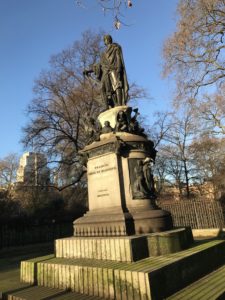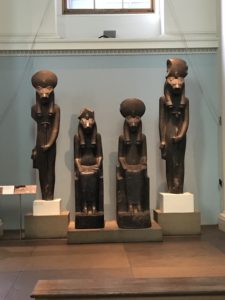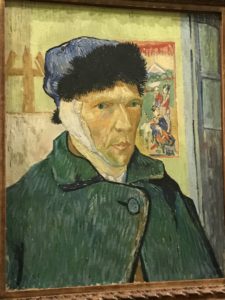Hello everyone! Today was museum day for us, beginning with the British Museum. We got there too early and were able to explore the area: it’s near University College London and the Camden neighborhood based on the signs we saw. In Gordon Square, in the middle of campus, they were filming a period piece based on the coaches and horses lining the street. The architecture was regency style on the side of the square they were using (I think – not an architecture expert here.) Found some cool shops and side streets to wander until we found ourselves in Russell Square Gardens – London has a wealth of parks, large and small. The small and tiny pocket parks are pleasant surprises in a dense urban environment, and this one was replete with a sponsoring lord’s statue: Francis, Duke of Bedford.

From the park, we went straight to the museum and headed for the three things we most wanted to see: the Rosetta Stone, the Egyptian collection and the Elgin marbles from the Parthenon. Crowds were not terrible at the Rosetta Stone, the first floor portion of the Egyptian collection or the Elgin marbles. By the time we completed these exhibits and moved to the third floor, where the remainder of the Egyptian exhibit is, crowds were thick. We were blocked from the some of the displays. Can’t imagine what it is like in high season.
We knew that the British Museum had the largest collection of Egyptian artifacts outside of Egypt, but even we were astonished at the breadth of it. The Rosetta Stone is fascinating, and the Elgin marbles are beautiful – both worth seeing. Of course, the museum is massive with thousands upon thousands of items from every time period. We simply could not do it all. Surprisingly, they did not care if you took photos, so here are a few.


After the museum, we were famished and found a pub called The Plough off a lane near the museum. We had a proper British lunch of cod and chips with peas (John, of course) and chicken and mushroom pie with mash and veg for me. So good!
Next, on to the Somerset House, a remarkable aristocratic home on the Thames that has been converted to multiple uses, including retail and restaurant space, meeting spaces, and the Courtauld Gallery, which houses a collection of artwork by a variety of masters including Caravaggio, Peter Paul Reuben’s, Degas, Cezanne, Monet, Picasso, Van Gogh and others. Again, we were shocked that they allowed photos, so we will post a few below.


The gallery was in incredible rooms with detailed ceilings that were works of art in their own right. The Somerset House has multiple wings set around a courtyard, which has one the most popular ice skating rinks in London during the holidays.

Of course, our pictures cannot do justice to these beautiful pieces; we just hope you know where to look for these masterpieces should you make a trip to London.
After leaving Somerset House, we got a little lost and just kept looking for someplace interesting to have dinner. In doing so, we accidentally found one of the sights on our to do list: the Temple Church. Consecrated in 1185, this was the home church of the Knights Templar in England during the Crusades. It si famous for being a round church, which is typical of Templar churches. They based the shape on the Dome of Rock in Jerusalem, which the Templars conquered in 1099.

A rectangle nave was added approximately 50 years later. When the Knights Templar were disbanded in the early 1300s, the church was taken by the crown and was used in various medical, clerical and teaching capacities for centuries. It escaped the Great Fire of 1666, was refurbished by Christopher Wren, and was damaged by fire due to German incendiary bombs in 1941. Despite all of this, the church still has services and continues to serve the community in a unique capacity. This was a great end to another busy day.
Thanks so much for reading our post. We will blog again tomorrow, but in the meantime, feel free to leave a comment. Thanks!